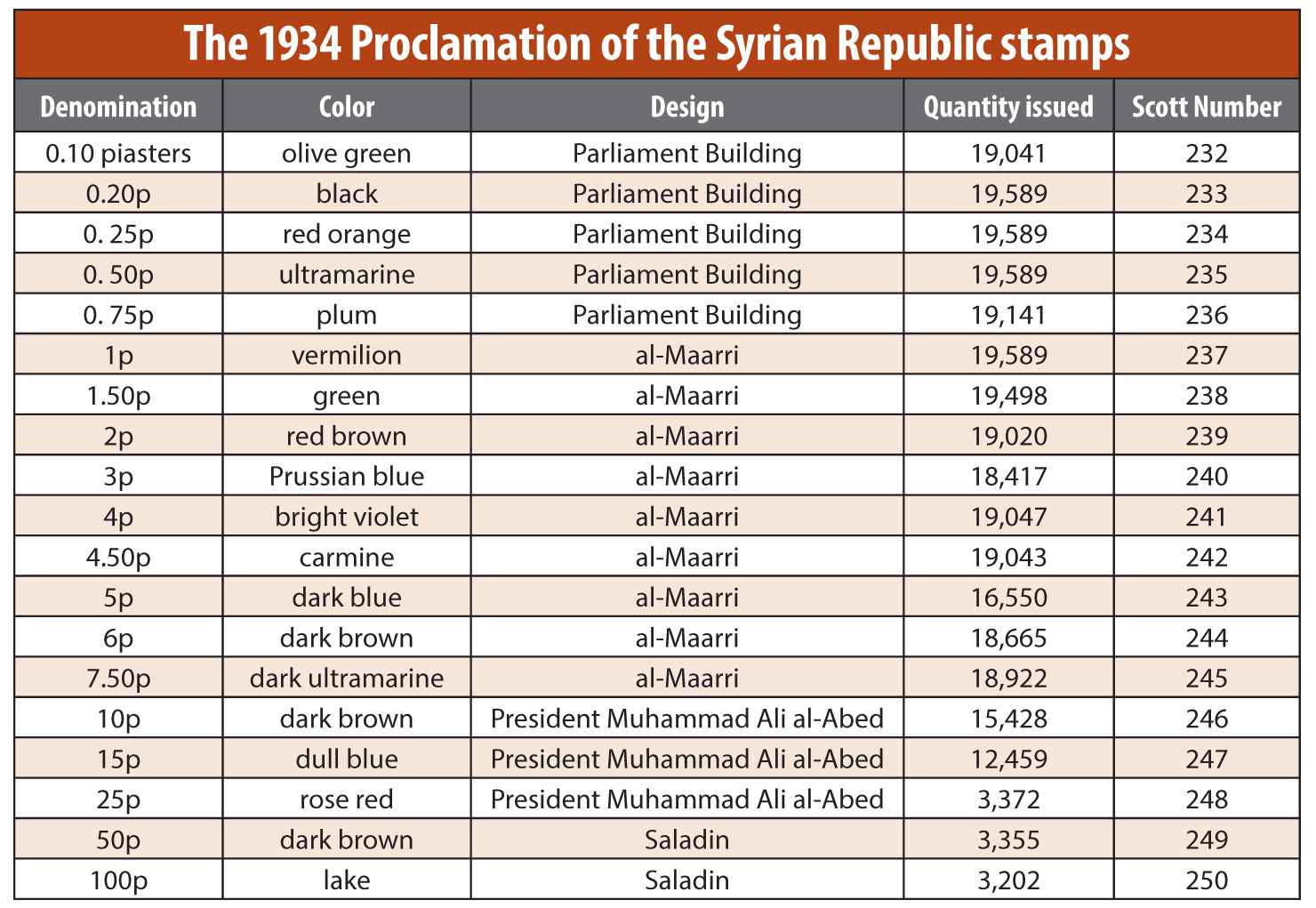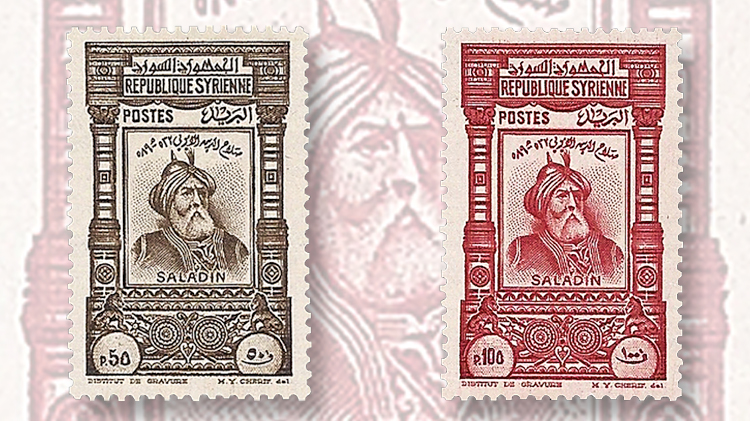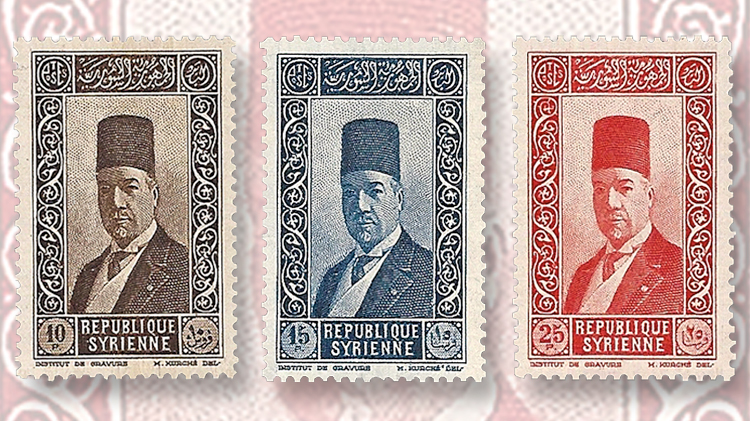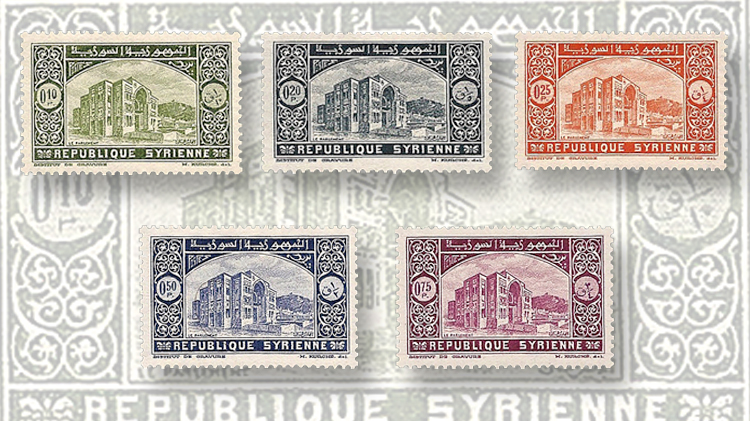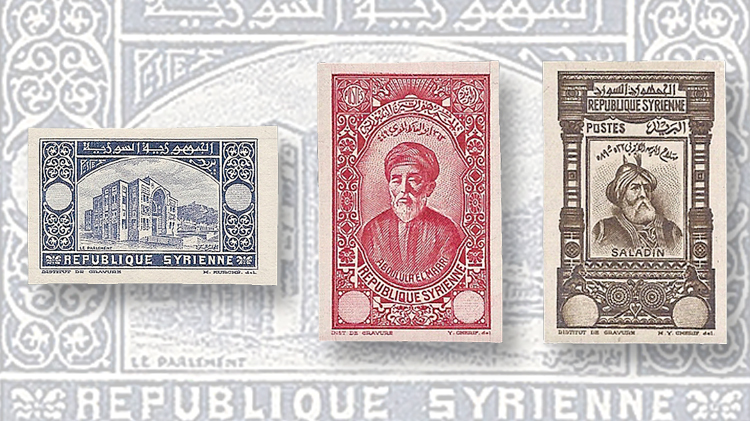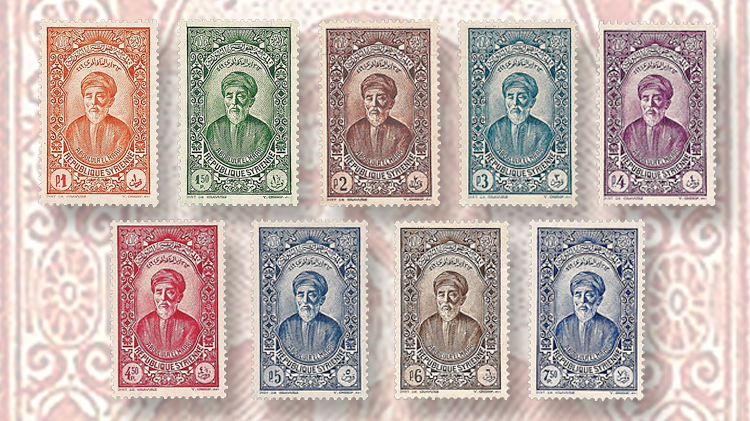World Stamps
Stamps issued in 1934 marked proclamation of the Syrian republic
By Ghassan Riachi
In 1930, the State of Syria became the Republic of Syria, and as a result, a new Syrian constitution was put into effect by the French.
On Aug. 2, 1934, the Syrian government issued postage and airmail stamps commemorating the establishment of the republic.
In this column, I will discuss the 19 stamps in the postage stamp set (Scott 232-250). In the grade of very fine, a complete set is valued at $228.75 unused and at $224.25 used in the 2016 Scott Standard Postage Stamp Catalogue.
Connect with Linn's Stamp News:
The stamps were issued on white unwatermarked paper and are perforated gauge 12½.
They were printed in two steps. First, the main design was engraved, and then the denomination and currency were added by typography.
Four different illustrations were selected for the designs.
The accompanying table gives the denomination, color, design, quantity issued, and Scott number for each perforated stamp in this set.
As shown in this table, the lowest quantity issued, 3,202, was for the high denomination, 100 piasters. Thus, only 3,202 complete perforated sets can be assembled.
However, over the years, I have seen many faulty stamps in all of the denominations, so the actual number of sound sets is much lower.
The 0.10-piaster perforated stamp exists with the denomination inscription doubled. This error is very rare; only 50 examples are believed to exist.
In addition, 300 sets were issued imperforate. The imperforate stamps exist as singles, pairs and blocks of four.
All the known imperforate stamps are unused. Some of them have lost their gum, while others exist with faults such as creases, tears and thins.
A few collectors of the stamps of Syria have two sets of this issue, one perforated and another imperforate. Finding fault-free stamps for an imperforate set can pose a challenge.
The first five denominations, 0.10p to 0.75p, are horizontal, all featuring the same central design of the parliament building in the Syrian capital, Damascus, surrounded by an ornate frame.
Above the central design is the word “post,” in French at left and in Arabic at right. Below the design is “The Parliament” in French at left and in Arabic at right.
The top center frame reads, “The Republic of Syria” in Arabic, with the same in French at the bottom center.
At the sides of the stamps are the currency and denomination, in Arabic at right and in French at left.
The designs of the remaining stamps in the set are vertical.
The central design of the 1p through 7.50p denominations depicts a portrait of al-Maarri (973-1057), a blind Arab writer, philosopher and poet who lived in seclusion and believed that rational thought should drive mankind.
His pessimistic views made him believe that children should not be born, in order to spare them from the hardships of life.
Above his portrait on the stamps are his name and life span (in Hijri years) in Arabic, “363 abu al-Alaa al-Maarri 449.” His name is in French below the portrait. Above and below al-Maarri’s name on the stamps is the name of the country, in Arabic at top and French at bottom.
The word “post” is inscribed in the top two corners, in Arabic at right and in French at left. In the bottom two corners are the denomination and currency, in French at left and in Arabic at right.
The third design, used for the 10p, 15p and 25p denominations, shows a portrait of President Muhammad Ali al-Abed (1867–1939), the first appointed president of Syria. Above the central design on the stamps is the country name in Arabic, with the same in French at bottom center.
The word “post” is in the top two corners, and the denomination and currency are in the bottom two corners. In both cases, the Arabic inscriptions are at right and French at left.
The 50p and 100p stamps picture Saladin (1138-93), the first sultan of Egypt and Syria. He is famous for leading the Muslim opposition in the Levant against the European crusaders.
Under Saladin’s command, the Ayyubid army defeated the crusaders in Jerusalem in 1187, at the Battle of Hattin, which paved the way for the Muslims to recapture Palestine from the crusaders who had occupied it for about 88 years.
Above Saladin’s portrait on the stamps are his name and life span (in Hijri years) in Arabic, “Salah al-Din al-Ayyubbi 532-589H.” Below the portrait is his name in French.
In the top center frame is the name of the country: in Arabic on top and in French below it. Underneath the country name is the word “post,” in Arabic at right and in French at left. In the bottom corners are the denomination and currency, also in Arabic at right and in French at left.
On all of the stamps, the bottom margins include the name of the printer at left and of the designer at right.
The printer was the Institut De Gravure (abbreviated as “Inst De Gravure” on the stamps showing al-Maarri) in Paris. The designers are M. Kurche for the Parliament Building and President Muhammad Ali el Abed designs, Y. Cherif for the al-Maarri design, and M. Y. Cherif for the Saladin design. On each stamp, “del,” meaning drew, follows the designer’s name.
Proofs in the same colors as the issued stamps exist. The proofs do not bear denominations.
For the perforated stamps, 100 proofs are believed to have been issued for each stamp. A proof of the 15p dull blue stamp (Scott 247) is shown nearby.
An unknown quantity of proofs of the imperforate stamps were issued. Three examples of these proofs (for the 0.50p ultramarine, 4.50p carmine, and 50p dark brown) are shown here.
Also, die proofs, progressive die proofs, progressive proofs or essays are known for this set, but they are not discussed here.
The intricate details of these stamps make them attractive, and their colors are vibrant and bold. Also, the clarity of these engraved designs almost makes the stamps look new even though they are more than 80 years old.
In my opinion, this stamp set captures some of the snapshots of the history of the country. When I was a young kid, my stamp collecting friends and I were fascinated by this set.
We struggled, trying to assemble a complete set. The top two denominations were very difficult for us to find. I remember that even back then dealers wanted premium prices for the stamps in this set.
Having grown up in Lebanon, Syria was our neighbor. The thought of what is occurring in that country now is saddening to me.
These stamps take me back to a happier place in time, and I hope that Syria finds strength and peace soon in order to return to happier times.
MORE RELATED ARTICLES
Headlines
-
US Stamps
Oct 7, 2024, 3 PMMcMurtrie dismissed as APS education director following Sept. 21 arrest
-
US Stamps
Oct 7, 2024, 12 PMVasiliauskas named president of Mystic Stamp Co.
-
US Stamps
Oct 6, 2024, 5 PMApgar souvenir card available
-
US Stamps
Oct 6, 2024, 4 PMFirst Continental Congress and U.N. stamps receive Scott catalog numbers
